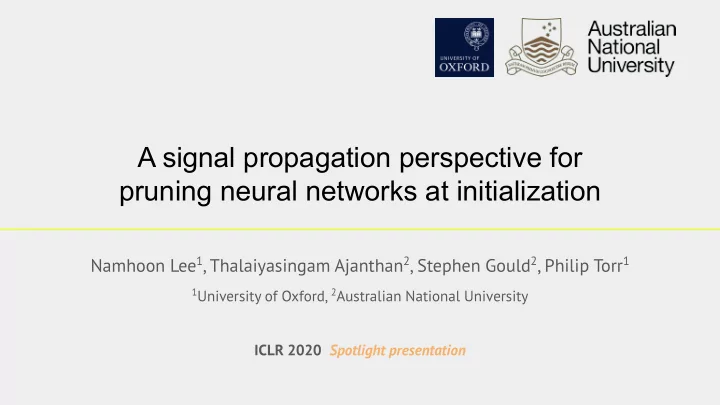

A signal propagation perspective for pruning neural networks at initialization Namhoon Lee 1 , Thalaiyasingam Ajanthan 2 , Stephen Gould 2 , Philip Torr 1 1 University of Oxford, 2 Australian National University ICLR 2020 Spotlight presentation
Motivation Han et al. 2015
Motivation A typical pruning approach requires training steps (Han et al . 2015, Liu et al . 2019) . Han et al. 2015
Motivation A typical pruning approach requires training steps (Han et al . 2015, Liu et al . 2019) . Pruning can be done efficiently at initialization prior to training based on connection sensitivity (Lee et al ., 2019) .
Motivation A typical pruning approach requires training steps (Han et al . 2015, Liu et al . 2019) . Pruning can be done efficiently at initialization prior to training based on connection sensitivity (Lee et al ., 2019) . The initial random weights are drawn from appropriately scaled Gaussians (Glorot & Bengio, 2010) .
Motivation A typical pruning approach requires training steps (Han et al . 2015, Liu et al . 2019) . Pruning can be done efficiently at initialization prior to training based on connection sensitivity (Lee et al ., 2019) . The initial random weights are drawn from appropriately scaled Gaussians (Glorot & Bengio, 2010) . It remains unclear exactly why pruning at initialization is effective.
Motivation A typical pruning approach requires training steps (Han et al . 2015, Liu et al . 2019) . Pruning can be done efficiently at initialization prior to training based on connection sensitivity (Lee et al ., 2019) . The initial random weights are drawn from appropriately scaled Gaussians (Glorot & Bengio, 2010) . It remains unclear exactly why pruning at initialization is effective. Our take ⇒ Signal Propagation Perspective .
Initialization & connection sensitivity Sparsity pattern Sensitivity scores
Initialization & connection sensitivity (Linear) uniformly pruned throughout the network. Sparsity pattern → learning capability secured . Sensitivity scores
Initialization & connection sensitivity (Linear) uniformly pruned throughout the network. Sparsity pattern → learning capability secured . (tanh) more parameters pruned in the later layers. → critical for high sparsity pruning . Sensitivity scores
Initialization & connection sensitivity (Linear) uniformly pruned throughout the network. Sparsity pattern → learning capability secured . (tanh) more parameters pruned in the later layers. → critical for high sparsity pruning . Sensitivity scores
Initialization & connection sensitivity (Linear) uniformly pruned throughout the network. Sparsity pattern → learning capability secured . (tanh) more parameters pruned in the later layers. → critical for high sparsity pruning . CS scores decrease towards the later layers. Sensitivity → Choosing top salient parameters globally results in scores a network, in which parameters are distributed non-uniformly and sparsely towards the end .
Initialization & connection sensitivity (Linear) uniformly pruned throughout the network. Sparsity pattern → learning capability secured . (tanh) more parameters pruned in the later layers. → critical for high sparsity pruning . CS scores decrease towards the later layers. Sensitivity → Choosing top salient parameters globally results in scores a network, in which parameters are distributed non-uniformly and sparsely towards the end . CS metric can be decomposed as . → necessary to ensure reliable gradient!
Layerwise dynamical isometry for faithful gradients Proposition 1 ( Gradients in terms of Jacobians ). For a feed-forward network, the gradients satisfy: , where denotes the error signal, is the Jacobian from layer to the output layer , and refers to the derivative of nonlinearity.
Layerwise dynamical isometry for faithful gradients Proposition 1 ( Gradients in terms of Jacobians ). For a feed-forward network, the gradients satisfy: , where denotes the error signal, is the Jacobian from layer to the output layer , and refers to the derivative of nonlinearity. Definition 1 ( Layerwise dynamical isometry ). Let be the Jacobian matrix of layer . The network is said to satisfy layerwise dynamical isometry if the singular values of are concentrated near 1 for all layers; i.e. , for a given , the singular value satisfies for all .
Signal propagation and trainability Signal propagation Trainability (sparsity: 90%)
Signal propagation and trainability Jacobian singular values (JSV) decrease as per Signal propagation increasing sparsity. → Pruning weakens signal propagation . JSV drop rapidly with random pruning, compared to connection sensitivity (CS) based pruning. → CS pruning preserves signal propagation better . Trainability (sparsity: 90%)
Signal propagation and trainability Jacobian singular values (JSV) decrease as per Signal propagation increasing sparsity. → Pruning weakens signal propagation . JSV drop rapidly with random pruning, compared to connection sensitivity (CS) based pruning. → CS pruning preserves signal propagation better . Correlation between signal propagation and trainability. Trainability → The better a network propagates signals, (sparsity: 90%) the faster it converges during training .
Signal propagation and trainability Jacobian singular values (JSV) decrease as per Signal propagation increasing sparsity. → Pruning weakens signal propagation . JSV drop rapidly with random pruning, compared to connection sensitivity (CS) based pruning. → CS pruning preserves signal propagation better . Correlation between signal propagation and trainability. Trainability → The better a network propagates signals, (sparsity: 90%) the faster it converges during training . Enforce Approximate Isometry : → Restore signal propagation and improve training!
Validations and extensions Modern networks Pruning without supervision Architecture sculpting Non-linearities Transfer of sparsity
Summary The initial random weights have critical impact on pruning. ● Layerwise dynamical isometry ensures faithful signal propagation. ● Pruning breaks dynamical isometry and degrades trainability of a neural network. ● Yet, enforcing approximate isometry can recover signal propagation and enhance trainability. A range of experiments verify the effectiveness of signal propagation perspective. ●
Recommend
More recommend